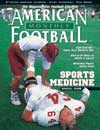AMERICAN FOOTBALL MONTHLY THE #1 RESOURCE FOR FOOTBALL COACHES
Article CategoriesAFM Magazine
|
Everyone on the Same Pageby: Jerry Kolowski, ATC© More from this issue In the absence of a certified athletic trainer, the head coach or coaches have many responsibilities as it relates to an injured athlete. During the course of a game, as one can imagine, all coaches are very involved with focusing on the next play, making the right substitutions, calling or signaling the right signs and searching for a way to win the game. One of the most difficult responsibilities for a coach is when an athlete is injured and his or her attention has to be refocused on ensuring that the athlete's safety and well being are given utmost priority. First and most important, the biggest problem for a coach is that many are not qualified to handle such injuries. Sure, some have received through their education a basic first-aid class or an introduction to an athletic training course. But a coach in that situation, ....The full article can only be seen by subscribers. Subscribe today!
|
|
|||||||
| HOME |
MAGAZINE |
SUBSCRIBE | ONLINE COLUMNISTS | COACHING VIDEOS |
Copyright 2025, AmericanFootballMonthly.com
All Rights Reserved





